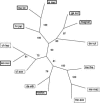Quantitative exploration of the occurrence of lateral gene transfer by using nitrogen fixation genes as a case study
- PMID: 16769896
- PMCID: PMC1480450
- DOI: 10.1073/pnas.0603534103
Quantitative exploration of the occurrence of lateral gene transfer by using nitrogen fixation genes as a case study
Abstract
Lateral gene transfer (LGT) is now accepted as an important factor in the evolution of prokaryotes. Establishment of the occurrence of LGT is typically attempted by a variety of methods that includes the comparison of reconstructed phylogenetic trees, the search for unusual GC composition or codon usage within a genome, and identification of similarities between distant species as determined by best blast hits. We explore quantitative assessments of these strategies to study the prokaryotic trait of nitrogen fixation, the enzyme-catalyzed reduction of N(2) to ammonia. Phylogenies constructed on nitrogen fixation genes are not in agreement with the tree-of-life based on 16S rRNA but do not conclusively distinguish between gene loss and LGT hypotheses. Using a series of analyses on a set of complete genomes, our results distinguish two structurally distinct classes of MoFe nitrogenases whose distribution cuts across lines of vertical inheritance and makes us believe that a conclusive case for LGT has been made.
Conflict of interest statement
Conflict of interest statement: No conflicts declared.
Figures





References
Publication types
MeSH terms
Substances
Grants and funding
LinkOut - more resources
Full Text Sources
Other Literature Sources
Research Materials
Miscellaneous

